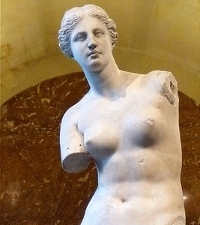 Milos is "The Island of Colours" thanks
to its volcanic origin. Most people will know of Milos from it's
connection with a famous statue in the Louvre, Paris... the "Venus
di Milo". Today, thanks to over 70 splendid and quite different
beaches with waters of every imaginable shade of green and blue, and
historical sights to be seen, tourism is catching on to this
fascinating, horseshoe shaped, Cycladic Island. The barrenness of
Milos and the scars of its immense amounts of quarrying and mining
should not deter visitors from appreciating the natural beauties of
the coast and the interesting historical sites to be found on Milos.
Milos is "The Island of Colours" thanks
to its volcanic origin. Most people will know of Milos from it's
connection with a famous statue in the Louvre, Paris... the "Venus
di Milo". Today, thanks to over 70 splendid and quite different
beaches with waters of every imaginable shade of green and blue, and
historical sights to be seen, tourism is catching on to this
fascinating, horseshoe shaped, Cycladic Island. The barrenness of
Milos and the scars of its immense amounts of quarrying and mining
should not deter visitors from appreciating the natural beauties of
the coast and the interesting historical sites to be found on Milos.
There are 7 towns on Milos, Adamas, Plaka, Pollonia, Triovassalos, Pera Triovassalos, Tripiti, and Plakes. The 3 largest being:
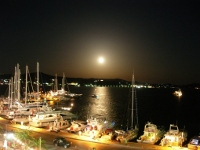 Adamas, is situated on the gulf and is the main port and hub of Milos, all
roads lead to Adamas! Thanks to it's pivotal position, right on the
gulf, it has built up a number of cafes, restaurants, discos, shops
and markets plus the majority of other services that might be
required. There are boat excursions that depart from Adamas as do
the ferries for Piraeus and the other western Cyclades islands of
Sifnos, Serifos and Kimolos. While in the town, the churches of
Aghia Triada and Agios Halarambos are worth visiting.
Adamas, is situated on the gulf and is the main port and hub of Milos, all
roads lead to Adamas! Thanks to it's pivotal position, right on the
gulf, it has built up a number of cafes, restaurants, discos, shops
and markets plus the majority of other services that might be
required. There are boat excursions that depart from Adamas as do
the ferries for Piraeus and the other western Cyclades islands of
Sifnos, Serifos and Kimolos. While in the town, the churches of
Aghia Triada and Agios Halarambos are worth visiting.
 Pollonia. Looking out towards the island of Kimolos, and 10 km (6¼
miles) northeast of Adamas. Pollonia is a small fishing town built
around a pretty round beach of fine sand. It is an ideal place for
those who want to be away from the crowds, close to all beaches on
the north side and to the nearby islands of Kimolos, Ag. Ghiorgos,
Poliegos, and Glaronissia, the impressive small islands coming up
from the sea with hexagon shaped stones.
Pollonia. Looking out towards the island of Kimolos, and 10 km (6¼
miles) northeast of Adamas. Pollonia is a small fishing town built
around a pretty round beach of fine sand. It is an ideal place for
those who want to be away from the crowds, close to all beaches on
the north side and to the nearby islands of Kimolos, Ag. Ghiorgos,
Poliegos, and Glaronissia, the impressive small islands coming up
from the sea with hexagon shaped stones.
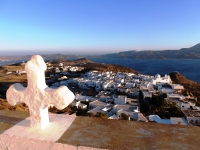 Plaka. Built on the hill Plaka is the most characteristic town on Milos Island with narrow roads,
houses of Cycladic style, and a few shops and restaurants. Be sure
to visit the Kastro, from where you'll have a wonderful view of the
north western part of the island and the stunning sunsets. In Plaka
you will also find a Folk Museum and an Archaeological Museum which
are both worth visiting. Not far from Plaka you will find an ancient Greek
theatre and the largest catacombs outside of Rome.
Plaka. Built on the hill Plaka is the most characteristic town on Milos Island with narrow roads,
houses of Cycladic style, and a few shops and restaurants. Be sure
to visit the Kastro, from where you'll have a wonderful view of the
north western part of the island and the stunning sunsets. In Plaka
you will also find a Folk Museum and an Archaeological Museum which
are both worth visiting. Not far from Plaka you will find an ancient Greek
theatre and the largest catacombs outside of Rome.
Two smaller villages on Milos island, but well worth visiting are Klima and Tripiti:
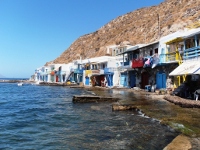 Klima:
Klima is a uniquely preserved little fishing village. As there is no
direct bus you must take a bus to Tripiti and then walk down (and
back up) 280 stairs. Otherwise a private car or scooter can take you
as far as the road goes to within about 50 meters.
Klima:
Klima is a uniquely preserved little fishing village. As there is no
direct bus you must take a bus to Tripiti and then walk down (and
back up) 280 stairs. Otherwise a private car or scooter can take you
as far as the road goes to within about 50 meters.
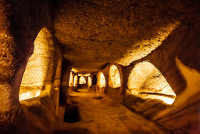 Tripiti:
Tripiti is a charming traditional hilltop village 5 km from Adamas,
2 km from Plaka and just above the picturesque harbour of Klima.
From here there are incredible sea views and you are conveniently
near the catacombs and ancient theatre as well as the spot the Venus
di Milo was found.
Tripiti:
Tripiti is a charming traditional hilltop village 5 km from Adamas,
2 km from Plaka and just above the picturesque harbour of Klima.
From here there are incredible sea views and you are conveniently
near the catacombs and ancient theatre as well as the spot the Venus
di Milo was found.
The beaches of Milos
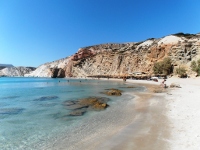 The southern beaches of Paliochori, Haghia Kiriaki, Tzigrado,
Firiplaka, Provatas and Gerontas on Milos tend to be sandy with
incredible shades of blue and green colouring the crystal clear
waters. Paliohori is probably the best sand beach of the island and
it has a couple tavernas and cafes.
The southern beaches of Paliochori, Haghia Kiriaki, Tzigrado,
Firiplaka, Provatas and Gerontas on Milos tend to be sandy with
incredible shades of blue and green colouring the crystal clear
waters. Paliohori is probably the best sand beach of the island and
it has a couple tavernas and cafes.
 Offering something entirely different, the northern beaches of Milos
are found amidst unusual rocks and their formations, creating
swimming spots that are beautiful and strange. Parafragas and
Sarakiniko are 2 of the unique northern rocky beaches of immense
beauty.
Offering something entirely different, the northern beaches of Milos
are found amidst unusual rocks and their formations, creating
swimming spots that are beautiful and strange. Parafragas and
Sarakiniko are 2 of the unique northern rocky beaches of immense
beauty.
Amongst the things you should not miss on Milos Island:
 An exploration of the many beautiful beaches of Milos by taking a boat tour around the island.
An exploration of the many beautiful beaches of Milos by taking a boat tour around the island.- In Polonia there is a SCUBA centre.
- The unusual beaches of Parafragas and Sarakiniko should be visited.
- The intricately curving paths of Plaka town.
- The catacombs and ancient theatre.
- The sandy beach of Paliohori.
- A visit to the fishing village of Klima.
Extra information about Milos:
There are many taxis on the island of Milos and it is usually easy to find one except perhaps during July and August at which time it advisable to have a transfer arranged to escort you upon arrival to your accommodation.
There are many restaurants on Milos, many open year round. Some of the ones in Adamas could generally do with some improvement. During the summer months you kind find a decent variety in Plaka. In Pollonia there is a good number of waterfront restaurants and tavernas and most are fairly good !
The "Hot Spas" of Milos are 100 m from the port. They are not kept up that well and have fluctuating opening hours.
Here is a suggested itinerary for a one day sightseeing tour of Milos:
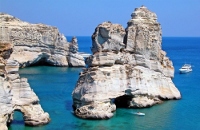 An exploration of the many beautiful beaches of Milos by taking a boat tour around the island.
Visit the Archaeological Museum of Milos to see a life-size replica of the famous statue Venus de Milo
(Aphrodite of Milos), the findings from Phylakopi and the 11,000-year history of Milos. Then continue to
the ancient city and the catacombs. Walk through the ruins of the walls of the ancient city and the
discovery site of Venus de Milo, and the Ancient Marble Theater, with great views of the Adamas bay.
The ancient marble theater appears to have been built on foundations of the Hellenistic period, bearing
a striking similarity to that of Ephesus in Asia Minor. After that go to the volcanic landscape of the
water-shaped and windswept luminous white rocks of Sarakiniko. The barren, lunar-like landscape of this
north coast beach of Milos is one of the most popular tourist attractions of the island. After Sarakiniko,
continue to the ancient town of Phylakope. The remaining ruins of walls, buildings and tombs are now
almost entirely covered by the water, but still bear witness of the life and civilisation existing there
during the Neolithic period. Just a few metres away from Phylakope, is the idyllic landscape of
Papafragas, one of the most impressive sites of Milos. From the top of the rock, it resembles a huge
natural swimming pool, an enormous cave carved out of the cliff’s side.
An exploration of the many beautiful beaches of Milos by taking a boat tour around the island.
Visit the Archaeological Museum of Milos to see a life-size replica of the famous statue Venus de Milo
(Aphrodite of Milos), the findings from Phylakopi and the 11,000-year history of Milos. Then continue to
the ancient city and the catacombs. Walk through the ruins of the walls of the ancient city and the
discovery site of Venus de Milo, and the Ancient Marble Theater, with great views of the Adamas bay.
The ancient marble theater appears to have been built on foundations of the Hellenistic period, bearing
a striking similarity to that of Ephesus in Asia Minor. After that go to the volcanic landscape of the
water-shaped and windswept luminous white rocks of Sarakiniko. The barren, lunar-like landscape of this
north coast beach of Milos is one of the most popular tourist attractions of the island. After Sarakiniko,
continue to the ancient town of Phylakope. The remaining ruins of walls, buildings and tombs are now
almost entirely covered by the water, but still bear witness of the life and civilisation existing there
during the Neolithic period. Just a few metres away from Phylakope, is the idyllic landscape of
Papafragas, one of the most impressive sites of Milos. From the top of the rock, it resembles a huge
natural swimming pool, an enormous cave carved out of the cliff’s side.
